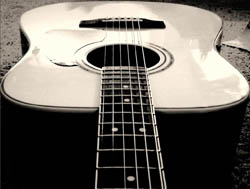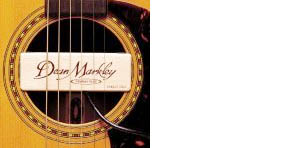There are several different types of pickups and microphones to choose from. Here is a basic overview.
Soundhole Magnetic Pickup
Pros: It’s easy, inexpensive, and can give decent results very quickly.
Cons: Because it is a magnetic pickup (like an electric guitar pickup), its sound is a little more dark and electronic sounding. Also, you have to deal with the annoying cable coming out of your soundhole.
Connection to PA: Direct box, external pre-amp, or acoustic amplifier.
Piezo Under-Saddle Pickups
Pros: The most popular method so everyone generally understands it. A clever way to get a lot of sound without causing a visual distraction. Very good at capturing the dynamics of the instrument. Not that expensive. Many models come with an included preamp.
Cons: The raw unamplified sound from these pickups is harsh, brassy, or banjo-esque. They need quality preamps in order to add the warmth needed to balance the sound out. The better the preamp, the better the resulting sound.
Connection to PA: Direct box, external pre-amp, or acoustic amplifier. You can always tell if the pickup is “active” (includes a preamp) if the instrument requires a battery. A battery always indicates the presence of a preamp.
Contact Transducers
Pros: Cheap and easy.
Cons: Sound quality is noticeably lower, requires adhesives (foam tape) to stay in place.
Connection to PA: Direct box, external pre-amp, or acoustic amplifier.
Taylor “ES” System
Pros: Uses a unique combination of a built-under-fretboard pickup and dynamic “body sensors” (pictured) which attempt to amplify the body characteristics in addition to the string sound. Great for percussive body-slap type players. It does produce a slightly more “natural” sound than piezo systems. Good at rejecting feedback. Balanced output.
Cons: Only included on expensive Taylor guitar models. Many players do not like the sound. Often requires drastic EQ. Uses special cabling for best results, which make it cumbersome to tune on-stage or use effects pedals.
Connection to PA: Because of its balanced output and special cable, it can be plugged directly into a console or snake. Or it can be run with a standard cable to standard connection options, but with a slightly noticeable drop in sound quality.
LR Baggs I-Beam System
Pros: A unique system that is placed inside the guitar, underneath the bridge plate, attaching with adhesive. Gives a very natural acoustic sound which many players prefer over typical under-saddle systems.
Cons: A little more expensive than its piezo under-saddle counterparts. Requires some finesse on installation to find the “sweet spot.”
Connection to PA: Direct box, external pre-amp, or acoustic amplifier
Internal Microphones
Pros: Can give a more natural, high quality sound and image, especially in classical and traditional fingerstyle formats.
Cons: But the quality comes with a price – high feedback probability in loud stage environments (ie: drums or brass). The fact that the microphone is inside the guitar cavity means the mic will be prone to swelling tones and sympathetic resonance.
Connection to PA: Most systems come with an included preamp, which allows the instrument to connect directly with a sound system or guitar amp.



























